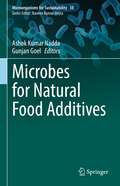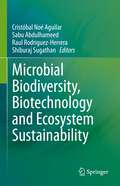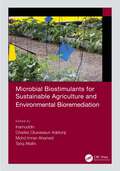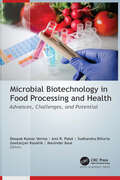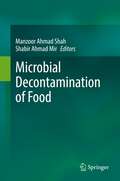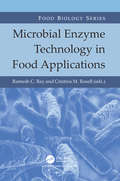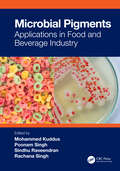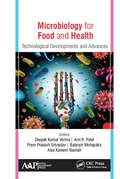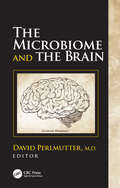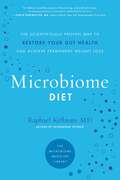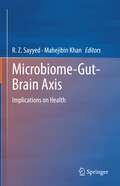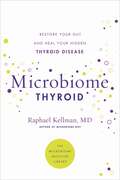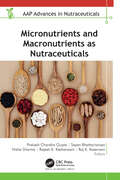- Table View
- List View
Michael Caines At Home
by Michael CainesMichael Caines, MBE, is a truly original British chef, who has created innovative and original dishes which have earned him two Michelin stars and numerous awards and accolades, including ‘the UK’s best all round restaurant’ (Hardens) and ‘perfect in every way’ (Sunday Times). For the last three years his flag ship restaurant, Gidleigh Park in Devon has been voted second only to Heston Blumenthal's Fat Duck as Britain's best restaurant.Michael Caines at Home is his first book which contains nearly 100 exciting, delicious recipes suitable for cooking in domestic kitchens, distilled from a life time of passionate cooking.
Michael Mina: The Cookbook
by Michael Mina JoAnn CianciulliA world-class chef and restaurateur shares his secrets and reveals how to create his trio concept, where a master recipe is followed by three flavor variations. Accompanying the trios are Mina's classic and most requested recipes from his restaurants. Full color.
Michel Roux at Home
by Michel Roux Jr.Discover the joy of cooking simple and delicious French meals at home with Michel Roux, the celebrated chef and author of numerous award-winning cookbooks.Journey into the heart of Michel Roux's home kitchen as he shares the mouth-watering everyday recipes he enjoys cooking and eating with his family and friends, including hearty breakfasts, quick lunches, simple suppers and weekend feasts.With a mix of family classics that have been passed down through the generations of the legendary Roux family, newer dishes that Michel loves to cook with his wife and daughter, and his own childhood favourites, this is accessible French food to cook at home. Drawing on his years of experience as a chef and restaurateur, at the core of each recipe is the use of simple, fresh ingredients and carefully crafted flavour combinations. Each with clear instructions and helpful tips to ensure success in your home kitchen. Alongside each of the delicious meals selected for different times of the week, is a collection of five seasonal menus, each perfect for special family celebrations at home.
Michigan's Town and Country Inns, 5th Edition
by Susan Jayne NewhofThe fifth edition of Michigan’s Town & Country Inns is a guide to more than 50 inns, bed-and-breakfast homes, and historic lodgings in the Upper and Lower Peninsulas of Michigan. Choose from lighthouses anchored to the rugged shores of Lake Superior, Victorian mansions built by lumber and mining barons, rustic log lodges, and romantic small town hideaways. Meet the innkeepers themselves, who range from retired military officers and corporate heads to artists and poets. You’ll find detailed descriptions of the accommodations along with information about rates, suitability for children, and policies on smoking and pets. Get a sense of the flavor and mood of each and learn about fun things to do in the surrounding areas. Numerous photos enhance the descriptions and provide a visitor’s-eye view of some of the most unusual and delightful places to stay in Michigan.
Microbes for Natural Food Additives (Microorganisms for Sustainability #38)
by Ashok Kumar Nadda Gunjan GoelThis book provides all the aspects of microbes for food additives, and a detailed description of their different categories. The chapters provide a step-by-step overview of microbial food additives as enzymes, antioxidants, stabilizers, emulsifiers, organic acids, colorants, sweeteners, flavoring compounds that have been used commercially by industrialists. In addition, an emphasis on the use of microbes as therapeutic agents such as probiotics and enzymes have also been given in the respective chapters. Furthermore, the book also comprises the detailed description of legislation and policies for the use of microbial additives at large scale in different food industries. Therefore, this book provides a comprehensive, state of art updated literature which can be used by the food scientists, nutritionists, microbiologists and a health-conscious layman to check the food additive list on a product for a nutritious and safer food.
Microbial Biocontrol: Volume 2
by Ajay KumarThis second volume of a two-volume work reviews beneficial bioactive compounds from various microorganisms such as bacteria, fungi, cyanobacteria in plant diseases management and the postharvest management of fruits using microbial antagonists. Furthermore, it reviews the impact of climate change on food security and addressed the legal aspects of microbial biocontrol applications. The two-volume work “Microbial Biocontrol” introduces to mechanisms of plant-microbe interactions and explores latest strategies of how microbes can be applied in biocontrol and management of plant pathogens, replacing chemical fertilizers and pesticides. The book covers different groups of microorganisms such as bacteria, fungi, but also the interplay of entire microbiomes, and reviews their specific benefits in crop growth promotion, in enhancing the plants’ tolerance against biotic and abiotic stress as well as in post-harvest management of various plant diseases. Novel tools such as CRISPR/Cas9 and microbe derived nanoparticles are also addressed besides the legal aspects of biocontrol applications. Today, rising global population and changing climatic conditions emerge as a major challenge for agronomist farmers and researchers in fulfilling the requirements of global food production. The conventional agricultural practices utilize undistributed use of chemical fertilizers and pesticides to enhance growth and yield of agricultural products and fresh foods, but their extensive and continuous use have led to a range of negative consequences on the food quality and safety, to environment as well as to human and animal health. Microbial biocontrol applications are presented as a solution, paving the way to a sustainable agriculture in compliance with the UN Sustainable Development Goals (SDG). The book addresses researchers in academia and agriculture.
Microbial Biocontrol: Volume 1
by Ajay KumarThis first volume of a two-volume work presents the manifold applications of beneficial microbes and microbiomes in plant growth promotion, in enhancing crop resilience and in control of phytopathogens through microbial antagonists. In-depth insights into latest technologies such as biopriming of seeds and soil inoculation of rhizosphere microorganisms are provided.The two-volume work “Microbial Biocontrol” introduces mechanisms of plant-microbe interactions and explores latest strategies of how microbes can be applied in biocontrol and management of plant pathogens, replacing chemical fertilizers and pesticides. The book covers different groups of microorganisms such as bacteria, fungi, but also the interplay of entire microbiomes, and reviews their specific benefits in crop growth promotion, in enhancing the plants’ tolerance against biotic and abiotic stress as well as in post-harvest management of various plant diseases. Novel tools such as CRISPR/Cas9 and microbe derived nanoparticles are also addressed besides the legal aspects of biocontrol applications.Today, rising global population and changing climatic conditions emerge as a major challenge for agronomist farmers and researchers in fulfilling the requirements of global food production. The conventional agricultural practices utilize undistributed use of chemical fertilizers and pesticides to enhance growth and yield of agricultural products and fresh foods, but their extensive and continuous use have led to a range of negative consequences on the food quality and safety, to environment as well as to human and animal health. Microbial biocontrol applications are presented as a solution, paving the way to a sustainable agriculture in compliance with the UN Sustainable Development Goals (SDG). The book addresses researchers in academia and agriculture.
Microbial Biodiversity, Biotechnology and Ecosystem Sustainability
by Cristóbal Noé Aguilar Sabu Abdulhameed Raul Rodriguez-Herrera Shiburaj SugathanThis book gives insight into several aspects of the microbiology, biotechnology, and ecosystem sustainability of special and under-explored regions, that captivate human beings by their natural richness, their extensive biodiversity, the extraordinary forms of adaptation of the living beings that they inhabit, and even that keep living secrets as is the very origin of life. The chapters emphasize all aspects of biological diversity-its description, analysis, and conservation, and its controlled rational use by humankind. Also, the book is elaborated from a wide and multidisciplinary point of view. It presents reviews, research papers, comments, and research notes on biodiversity, ethnobiology, geoscience, chemistry, biological conservation, biotechnology, and ecosystem sustainability Two hotspots are the reference for this enriching book that describes details of extraordinary areas of the planet, from Cuatrociénegas, Coahuila (Mexico) to the Southern Western Ghats (India). The book will contribute to dealing with the practicalities of conservation management, economic, social, and political issues. It provides a forum for examining conflicts between sustainable development and human dependence on biodiversity in agriculture, environmental management, and biotechnology, and encourages contributions from developing countries to promote broad global perspectives on matters of biodiversity and conservation.
Microbial Biostimulants for Sustainable Agriculture and Environmental Bioremediation
by Charles Oluwaseun Adetunji Mohd Imran Ahamed Tariq Altalhi InamuddinToday, the agriculture industry is confronted with simultaneous issues of how to fully embrace mass production of safer food in terms of both quality and quantity. Most industries are concerned with avoiding significant levels of soil pollution and environmental threats as a result of the excessive and harmful use of synthetic products on crops. Therefore, there is a need to adopt sustainable technological innovations that can ensure the sustainability of agricultural production systems.Microbial Biostimulants for Sustainable Agriculture and Environmental Bioremediation discusses the benefits, challenges, and practical applications of eco-friendly biotechnological techniques using biostimulants derived from beneficial microorganisms. The chapters cover the use of these organisms to increase crop production, enhance soil fertility and maintain soil health, create crop and plant tolerance to different abiotic stressors, release required nutrients to the soil, increase resistance to plant pathogens/pests, improve nutrient use efficiency of crops, and rejuvenate polluted environments.FEATURES Explores the physiological, morpho-anatomical, and biochemical molecular plant rejoinders involved in stimulating crop productivity Provides information on the physiological, cellular, and molecular modes of action underlying microbial biostimulant interfaces Summarizes methods and approaches for executing microbial stimulant technology Outlines numerous environmental management and remediation strategies This book is an ideal resource for researchers, engineers, and academics working in soil science, crop science, water remediation, microbiology, and biotechnology.
Microbial Biostimulants for Sustainable Agriculture and Environmental Bioremediation
by InamuddinToday, the agriculture industry is confronted with simultaneous issues of how to fully embrace mass production of safer food in terms of both quality and quantity. Most industries are concerned with avoiding significant levels of soil pollution and environmental threats as a result of the excessive and harmful use of synthetic products on crops. Therefore, there is a need to adopt sustainable technological innovations that can ensure the sustainability of agricultural production systems.Microbial Biostimulants for Sustainable Agriculture and Environmental Bioremediation discusses the benefits, challenges, and practical applications of eco-friendly biotechnological techniques using biostimulants derived from beneficial microorganisms. The chapters cover the use of these organisms to increase crop production, enhance soil fertility and maintain soil health, create crop and plant tolerance to different abiotic stressors, release required nutrients to the soil, increase resistance to plant pathogens/pests, improve nutrient use efficiency of crops, and rejuvenate polluted environments.FEATURES Explores the physiological, morpho-anatomical, and biochemical molecular plant rejoinders involved in stimulating crop productivity Provides information on the physiological, cellular, and molecular modes of action underlying microbial biostimulant interfaces Summarizes methods and approaches for executing microbial stimulant technology Outlines numerous environmental management and remediation strategies This book is an ideal resource for researchers, engineers, and academics working in soil science, crop science, water remediation, microbiology, and biotechnology.
Microbial Biotechnology in Food Processing and Health: Advances, Challenges, and Potential
by Deepak Kumar Verma Ami R. Patel Sudhanshu Billoria Geetanjali Kaushik Maninder KaurThis new volume considers how the application of microbial biotechnology in food processing provides nutritional health benefits in foods, focusing on new probiotics and prebiotic-based foods. It provides an informative state-of-the art perspective of the food industry on probiotics and their metabolites, assesses the specific potential health benefits of probiotics in foods, and presents new research and advances on industrial aspects of microbial food technologies. The first section discusses the types and roles of beneficial microbes and/or their metabolites in food products, such as in enhancing food safety by decontaminating or neutralizing toxic components like mycotoxins associated with foods. Section 2 elaborates on recent breakthroughs in the development of novel probiotics incorporated in dairy and non-dairy food products (such as fruits and vegetables), challenges associated with commercialization, and their health benefits. The third section delves into emerging technologies that deal with assessing microbial diversities or management of microbiological hazards in food products.
Microbial Biotechnology in Food Processing and Health: Advances, Challenges, and Potential
by Deepak Kumar Verma Ami R. Patel Sudhanshu Billoria Geetanjali Kaushik Maninder KaurThis new volume considers how the application of microbial biotechnology in food processing provides nutritional health benefits in foods, focusing on new probiotics and prebiotic-based foods. It provides an informative state-of-the art perspective of the food industry on probiotics and their metabolites, assesses the specific potential health benefits of probiotics in foods, and presents new research and advances on industrial aspects of microbial food technologies. The first section discusses the types and roles of beneficial microbes and/or their metabolites in food products, such as in enhancing food safety by decontaminating or neutralizing toxic components like mycotoxins associated with foods. Section 2 elaborates on recent breakthroughs in the development of novel probiotics incorporated in dairy and non-dairy food products (such as fruits and vegetables), challenges associated with commercialization, and their health benefits. The third section delves into emerging technologies that deal with assessing microbial diversities or management of microbiological hazards in food products.
Microbial Decontamination of Food
by Manzoor Ahmad Shah Shabir Ahmad MirFood is contaminated in the production chain and is the point of concern among the consumers and industries. There is also a considerable increase in foodborne outbreaks, which possess the challenge to industry associated with the production of processed food. Various strategies are used to prevent the contamination during postharvest stage, storage and distribution. Different methods are exploited for degrading or eliminating the microbial contamination from food commodities. The conventional techniques used for decontamination demanded a considerable requirement for novel technologies, which are efficient, environmental friendly, and cost-effective. Novel technologies efficiently remove the contamination without adversely affecting the nutritional properties and sensory characteristics of food material. There is a lack of scientific information on the microbial decontamination of different food commodities such as fruits, vegetables, cereals, sprouts, microgreens, meat, poultry, milk, nut, spices etc. under one umbrella. The application of conventional and novel technologies for improving the food safety of individual food commodities will be addresses in this book. Written by several experts in the field, this book is a valuable source for students, scientists, and professionals in food science, food microbiology, food technology, food processing, and other allied sciences.
Microbial Enzyme Technology in Food Applications (Food Biology Series)
by Ramesh C. Ray and Cristina M. RosellThe aim of food processing is to produce food that is palatable and tastes good, extend its shelf-life, increase the variety, and maintain the nutritional and healthcare quality of food. To achieve favorable processing conditions and for the safety of the food to be consumed, use of food grade microbial enzymes or microbes (being the natural biocatalysts) is imperative. This book discusses the uses of enzymes in conventional and non-conventional food and beverage processing as well as in dairy processing, brewing, bakery and wine making. Apart from conventional uses, the development of bioprocessing tools and techniques have significantly expanded the potential for extensive application of enzymes such as in production of bioactive peptides, oligosaccharides and lipids, flavor and colorants. Some of these developments include extended use of the biocatalysts (as immobilized/encapsulated enzymes), microbes (both natural and genetically modified) as sources for bulk enzymes, solid state fermentation technology for enzyme production. Extremophiles and marine microorganisms are another source of food grade enzymes. The book throws light on potential applications of microbial enzymes to expand the base of food processing industries.
Microbial Enzyme Technology in Food Applications (Food Biology Series)
by Ramesh C. Ray Cristina M. RosellThe aim of food processing is to produce food that is palatable and tastes good, extend its shelf-life, increase the variety, and maintain the nutritional and healthcare quality of food. To achieve favorable processing conditions and for the safety of the food to be consumed, use of food grade microbial enzymes or microbes (being the natural biocatalysts) is imperative. This book discusses the uses of enzymes in conventional and non-conventional food and beverage processing as well as in dairy processing, brewing, bakery and wine making. Apart from conventional uses, the development of bioprocessing tools and techniques have significantly expanded the potential for extensive application of enzymes such as in production of bioactive peptides, oligosaccharides and lipids, flavor and colorants. Some of these developments include extended use of the biocatalysts (as immobilized/encapsulated enzymes), microbes (both natural and genetically modified) as sources for bulk enzymes, solid state fermentation technology for enzyme production. Extremophiles and marine microorganisms are another source of food grade enzymes. The book throws light on potential applications of microbial enzymes to expand the base of food processing industries.
Microbial Pigments: Applications in Food and Beverage Industry
by Mohammed Kuddus Poonam Singh Raveendran Sindhu Rachana SinghMicrobial Pigments: Applications in Food and Beverage Industry offers a comprehensive and updated review of the impact of microbial pigments as value-added products in the food and beverage industry. Microbes produce a range of valuable pigments such as carotenoids, flavins, melanins, quinines, and violacein. The book explores the use of microbial pigments as additives, antioxidants, color intensifiers, and functional food ingredients. It discusses pigment isolation and processing technologies. It covers a range of applications across products like jams, spreads, frozen desserts, and beverages. The book also discusses food safety and toxicology aspects. Key features Explores the various microbial pigments and their sources Reviews the pigment isolation, production, and processing techniques Discusses the potential application of pigments across a range of products in the food and beverage industry Includes the latest innovations and patents awarded in use of microbial pigments as value-added food products The book is meant for researchers, academic and industry experts in food biotechnology, food processing, and food microbiology.
Microbial Pigments: Applications in Food and Beverage Industry
Microbial Pigments: Applications in Food and Beverage Industry offers a comprehensive and updated review of the impact of microbial pigments as value-added products in the food and beverage industry. Microbes produce a range of valuable pigments such as carotenoids, flavins, melanins, quinines, and violacein. The book explores the use of microbial pigments as additives, antioxidants, color intensifiers, and functional food ingredients. It discusses pigment isolation and processing technologies. It covers a range of applications across products like jams, spreads, frozen desserts, and beverages. The book also discusses food safety and toxicology aspects. Key features Explores the various microbial pigments and their sources Reviews the pigment isolation, production, and processing techniques Discusses the potential application of pigments across a range of products in the food and beverage industry Includes the latest innovations and patents awarded in use of microbial pigments as value-added food products The book is meant for researchers, academic and industry experts in food biotechnology, food processing, and food microbiology.
Microbiology for Food and Health: Technological Developments and Advances
by Deepak Kumar Verma Ami R. Patel Prem Prakash Srivastav Balaram Mohapatra Alaa Kareem NiamahThis book, Microbiology for Food and Health: Technological Developments and Advances, highlights the innovative microbiological approaches and advances made in the field of microbial food industries. The volume covers the most recent progress in the field of dairy and food microbiology, emphasizing the current progress, actual challenges, and successes of the latest technologies. This book looks at technological advances in starter cultures, prospective applications of food-grade microorganisms for food preservation and food safety, and innovative microbiological approaches and technologies in the food industry. The first series of chapters discuss the types, classification, and systematic uses of various starter cultures in addition to probiotics for various commercial fermentation processes. The book goes on to covers recent breakthroughs in microbial bioprocessing that can be employed in the food and health industry, such as, for an example, prospective antimicrobial applications of inherently present fermentative microflora against spoilage and pathogenic type microorganisms; the use of potential probiotic LAB biofilms for the control of formation of pathogenic biofilms by exclusion mechanisms, and more.
Microbiology for Food and Health: Technological Developments and Advances
by Deepak Kumar Verma Ami R. Patel Prem Prakash Srivastav Balaram Mohapatra Alaa Kareem NiamahThis book, Microbiology for Food and Health: Technological Developments and Advances, highlights the innovative microbiological approaches and advances made in the field of microbial food industries. The volume covers the most recent progress in the field of dairy and food microbiology, emphasizing the current progress, actual challenges, and successes of the latest technologies. This book looks at technological advances in starter cultures, prospective applications of food-grade microorganisms for food preservation and food safety, and innovative microbiological approaches and technologies in the food industry. The first series of chapters discuss the types, classification, and systematic uses of various starter cultures in addition to probiotics for various commercial fermentation processes. The book goes on to covers recent breakthroughs in microbial bioprocessing that can be employed in the food and health industry, such as, for an example, prospective antimicrobial applications of inherently present fermentative microflora against spoilage and pathogenic type microorganisms; the use of potential probiotic LAB biofilms for the control of formation of pathogenic biofilms by exclusion mechanisms, and more.
The Microbiome and the Brain
by David PerlmutterBrain related disorders are among the most challenging health issues of our time. The development of effective therapeutic and preventive strategies for these disorders relies on a comprehensive understanding of the underlying causative mechanisms. And, until recently, these mechanisms have remained somewhat elusive. The newly discovered pivotal role of the intestinal microbiome in brain health, functionality, and resistance to disease is revolutionizing neuroscience. The Microbiome and the Brain, through the contributions of some of the most forward thinking researchers and clinicians in the field, comprehensively reveals the leading edge of our understanding of the fundamental role of gut microbes and their metabolites in a wide array of seemingly diverse brain issues including Alzheimer’s disease, autism, multiple sclerosis, and mood disorders. In addition, mechanisms defining these relationships are explored along with a presentation of the state-of-the-art as it relates to interpretation of relevant laboratory assessments. Finally, novel therapeutic opportunities, derived from this exciting science are presented. Readers will learn: The highly validated relationship between alterations of gut microbes and their metabolites, and risk for Alzheimer’s disease. The important link between autism and intestinal dysbiosis. Appropriate interpretation of available laboratory assessments of the intestinal microbiome. The potential role of fecal microbial transplant in neurological diseases. The influence of diet and other lifestyle choices on the microbiome as it relates to brain health and functionality.
The Microbiome and the Brain
by David PerlmutterBrain related disorders are among the most challenging health issues of our time. The development of effective therapeutic and preventive strategies for these disorders relies on a comprehensive understanding of the underlying causative mechanisms. And, until recently, these mechanisms have remained somewhat elusive. The newly discovered pivotal role of the intestinal microbiome in brain health, functionality, and resistance to disease is revolutionizing neuroscience. The Microbiome and the Brain, through the contributions of some of the most forward thinking researchers and clinicians in the field, comprehensively reveals the leading edge of our understanding of the fundamental role of gut microbes and their metabolites in a wide array of seemingly diverse brain issues including Alzheimer’s disease, autism, multiple sclerosis, and mood disorders. In addition, mechanisms defining these relationships are explored along with a presentation of the state-of-the-art as it relates to interpretation of relevant laboratory assessments. Finally, novel therapeutic opportunities, derived from this exciting science are presented. Readers will learn: The highly validated relationship between alterations of gut microbes and their metabolites, and risk for Alzheimer’s disease. The important link between autism and intestinal dysbiosis. Appropriate interpretation of available laboratory assessments of the intestinal microbiome. The potential role of fecal microbial transplant in neurological diseases. The influence of diet and other lifestyle choices on the microbiome as it relates to brain health and functionality.
The Microbiome Diet: The Scientifically Proven Way To Restore Your Gut Health And Achieve Permanent Weight Loss (Microbiome Medicine Library)
by Raphael KellmanCutting-edge science has shown that the microbiome is the key to overall mental and physical health,and the secret behind healthy, sustainable weight loss. Drawing on nearly two decades of experience as a specialist in functional medicine and intestinal health, Dr. Raphael Kellman has developed the first diet based on these scientific breakthroughs. Offering a proven program to heal your gut and reset your metabolism, along with meal plans and 50 delicious chef-created recipes, The Microbiome Diet is the key to safe, sustainable weight loss and a lifetime of good health. Dr. Kellman masterfully presents a life enhancing, actionable plan based on this emerging science in a way that is user-friendly, for all of us.",Dr. David Perlmutter, New York Times bestselling author of Grain Brain
Microbiome-Gut-Brain Axis: Implications on Health
by R. Z. Sayyed Mahejibin KhanThe book highlights the importance of prebiotics, probiotics and synbiotics in the signalling mechanism between gut microbiota and brain, also referred to as the gut-brain axis. A stable gut microbiota is essential for normal gut physiology and overall health, since it assists in proper signalling along the brain–gut axis. The book describes how the cross talks between gut microbiota and brain, not only regulate gastro-intestinal functions but also ensure proper functioning of cognitive behaviour and immunological functions. The various chapters describe probiotic microorganisms that colonize gastrointestinal tract and provide an array of health benefits to the host. It further elaborates about certain non-digestible oligosaccharides (prebiotics) are easily fermented by specialist microbes in the gut, to produce health-promoting metabolites and inhibit the growth of pathogenic bacteria. This book is useful for students, researchers and scientists in the field of microbiology, food science and nutrition. It is also meant for industry experts involved in developing nutraceuticals.
Microbiome Thyroid: Restore Your Gut and Heal Your Hidden Thyroid Disease (Microbiome Medicine Library)
by Raphael KellmanThe leader in Microbiome Medicine offers a revelatory guide to the gut-thyroid connection, with cutting-edge information—and a surprising source of thyroid illness If you are one of the 20 million Americans living with thyroid disease or one of the thousands living undiagnosed, Dr. Raphael Kellman understands your suffering. Between inaccurate diagnosis, a wide spectrum of symptoms, and doctors who may not be familiar with the intricacies of thyroid dysfunction, it&’s hard to get the treatment you need. While general hypothyroidism and Hashimoto&’s thyroiditis are the most commonly known thyroid issues, there is an underdiagnosed and yet incredibly prevalent condition: Non-thyroidal Illness Syndrome (NTIS). It can cause unexplained fatigue, memory issues, problems with focus and decision making, and even dementia, and affects as many as 20% of Hashimoto&’s sufferers. Luckily, Dr. Kellman has a clinically proven, expert protocol that has given thousands of patients a path to health—and now he&’s delivering it to you. You&’ll discover: How your thyroid function affects your overall health—and how its dysfunction can explain your troubling symptoms The 4P Protocol for healing the microbiome How everyday household products, cosmetics, plastics, and medicines can disrupt your hormonal systems—and how to detoxA 30-Day Thyroid Rescue program, including meal plans and lifestyle changes Microbiome Thyroid helps you take control of your environment, your diet, and your life, guiding you toward the right diagnosis, the right treatment, and overall hormone balance.
Micronutrients and Macronutrients as Nutraceuticals (AAP Advances in Nutraceuticals)
by Prakash Chandra Gupta Sayan Bhattacharyya Nisha Sharma Rajesh K. Kesharwani Raj K. KeservaniThis new volume explains in detail the properties of micronutrients and macronutrients and their diverse uses as nutraceuticals for their beneficial properties, such as their antioxidant activity and immunity-boosting properties and how they can be incorporated into the human diet for optimum health, for growing beneficial bacteria in the gut, and inhibition of pathogens. Interestingly, the authors look at how disease-promoting habits often unfold in childhood, even prenatally, and employing nutrigenomics early on goes a long way toward curbing these chronic diseases later on in life. With the advent of increasing drug costs and escalating antimicrobial resistance, the pharmacological and antibiotic-like effects of naturally derived nutraceuticals are worth exploring. This volume provides important information toward that goal that will be valuable for researchers, faculty, and graduate students in medical microbiology, pharmacy, chemical engineering, and medical informatics.




